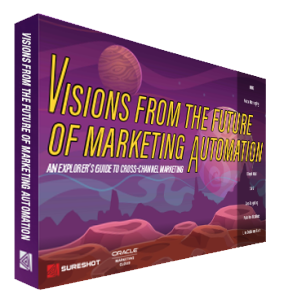
Visions from the Future of Marketing Automation: Intro
REACHING CUSTOMERS AT THE POINT OF ENGAGEMENT
The Role of Cross-Channel Marketing
Today’s B2B customers are tech-savvy, phone-dependent and mobile. They have high expectations that include your business connecting with them via the channels of their choice, from email, social media, text messages and push notifications, to voicemail, direct mail, live calls, and more.
Marketing and the “Rule of Seven”
As you are likely aware, the “Rule of Seven” states that a prospective customer must see or hear your marketing message a minimum of seven times before they are willing to commit to taking action. Cross-channel (AKA Omni-channel) marketing makes reaching this magical number quick and easy. However, just because you can use a channel doesn’t mean you should. It’s important to consider the ideal role and use for each channel in your arsenal in order to use them wisely.
Cross-Channel — The Swiss Army Knife of Marketing
In the same way you wouldn’t use a Phillips screwdriver to do a knife’s job, you shouldn’t use a push notification to do an email’s job. As you plan your campaign, think carefully about how your customers like to connect with you and the type of message you need to communicate. Then, choose the right channel for the job. When companies don’t carefully select the right channels for each message, they risk becoming intrusive and annoying to their audience.
BEST PRACTICES FOR CROSS-CHANNEL MARKETING
Cross-channel marketing is not hard, but it does require planning and coordination to ensure you provide customers with a consistent experience of your brand across all channels. To help you plan a successful cross-channel strategy, we recommend you:
1 – Use a Cross-Channel Marketing Platform:
From visibility and metrics to making complex campaigns simple to execute, a great platform is a must. When used correctly, it will save your team time, hassle and money, all while arming you with customer information and insights that empower you to achieve business goals.
2 – Know Your Audience:
As you collect data about your target market and individual customers, patterns will emerge. Use this information to personalize your approach and make your marketing messages more relevant to customer needs.
3 – Understand Your Channel
In this eBook, we’ve explored many individual marketing channels that you should be using in your cross-channel approach. You’ll find best practices, use cases and more that will help you use them in a way that benefits your business, your marketing strategy and your customers.
4 – Establish Campaign/Brand Continuity Across All Channels:
Good design instills confidence and consistent messaging builds trust, so make sure your marketing messages present a united brand voice across all channels.
5 – Optimize the Right Channels:
As you test various channels and campaigns, your data will reveal what’s working and what’s not, enabling you to adapt quickly and spend your budget where it matters most.
Download the complete ebook: Visions from the Future of Marketing Automation today!

